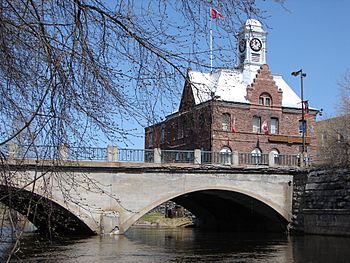Muskrat River (Ontario) facts for kids
Quick facts for kids Muskrat River |
|
|---|---|

The Muskrat River at Pembroke, Ontario
|
|
|
Location of the mouth of the Muskrat River in Ontario
|
|
| Country | Canada |
| Province | Ontario |
| County | Renfrew |
| Municipalities |
|
| Physical characteristics | |
| Main source | Edmunds Lake Township of Whitewater Region 164 m (538 ft) 45°33′48″N 76°43′58″W / 45.56333°N 76.73278°W |
| River mouth | Ottawa River Pembroke 110 m (360 ft) 45°49′45″N 77°06′49″W / 45.82917°N 77.11361°W |
| Basin features | |
| Tributaries |
|
The Muskrat River is a cool river in Renfrew County, Ontario, Canada. It flows into the big Ottawa River right at the city of Pembroke.
Contents
Journey of the Muskrat River
The Muskrat River starts its journey at Edmunds Lake. This lake is one of the Champlain Trail Lakes. It's also close to a community called Garden of Eden.
The river then flows northwest. It passes through other Champlain Trail lakes. The biggest of these is Jeffrys Lake. The river keeps going northwest. It even loops under Ontario Highway 17.
Joining Other Creeks
A stream called Buttermilk Creek joins the Muskrat River. This happens just before the river reaches Muskrat Lake. Muskrat Lake is near the community of Cobden.
At Muskrat Lake, another stream joins. This one is called Snake River. The Muskrat River then leaves the lake near Meath Hill. It continues flowing northwest.
The river loops under Ontario Highway 17 again. It takes in Mud Creek at Mud Lake. Finally, the Indian River joins. After that, the Muskrat River reaches its end. It flows into the Ottawa River at Pembroke.
River's Role in History
The Muskrat River was once very important for the city of Pembroke. It helped to create hydroelectric power. This means it used the force of its flowing water to make electricity. This power helped light up homes and businesses in Pembroke.
Wildlife Along the River
The Muskrat River is a special place for wildlife. In the fall, thousands of swallows gather here. Swallows are small birds known for their graceful flight. They stop at the mouth of the river. This is a resting spot for them. From here, they continue their long migration south. They fly to warmer places for the winter.
Streams That Feed the River
Many smaller streams flow into the Muskrat River. These are called tributaries. They help keep the river full of water.
- Indian River (joins from the left side)
- Mud Creek (joins from the left side)
- Snake River (joins from the left side)
- Buttermilk Creek (joins from the right side)


